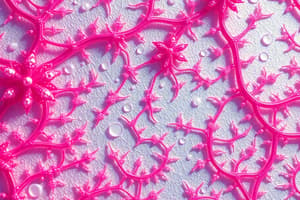Podcast
Questions and Answers
What is the primary function of epithelial tissue?
What is the primary function of epithelial tissue?
- Generates movement
- Forms protective barriers (correct)
- Provides support and stability
- Transmits nerve impulses
Which type of tissue facilitates communication between different parts of the body?
Which type of tissue facilitates communication between different parts of the body?
- Epithelial tissue
- Connective tissue (correct)
- Nervous tissue
- Muscle tissue
What is the role of muscle tissue in the body?
What is the role of muscle tissue in the body?
- Transmits signals via nerve impulses
- Generates movement by contracting and relaxing fibers (correct)
- Forms protective barriers
- Provides mechanical strength and stability
Histology is the study of:
Histology is the study of:
Which function of tissues involves shielding against injury, infection, and environmental hazards?
Which function of tissues involves shielding against injury, infection, and environmental hazards?
What distinguishes connective tissue from other types of tissues?
What distinguishes connective tissue from other types of tissues?
What is histology?
What is histology?
Which type of tissue consists of longitudinally aligned muscle fibers?
Which type of tissue consists of longitudinally aligned muscle fibers?
What is the main function of epithelial tissues?
What is the main function of epithelial tissues?
Connective tissues can be divided into classes based on the amount of:
Connective tissues can be divided into classes based on the amount of:
How many types of epithelium are there based on their shape, size, and packing arrangements of cells?
How many types of epithelium are there based on their shape, size, and packing arrangements of cells?
Which architectural pattern involves cells arranged in flat sheets or tubes forming continuous layers?
Which architectural pattern involves cells arranged in flat sheets or tubes forming continuous layers?
Study Notes
Tissues: Building Blocks of Life's Structures
Tissues are the fundamental structural and functional units within living organisms, composed of specialized cells organized into coherent groups with similar activities. These tiny building blocks combine to form organs and systems essential for life processes. In this exploratory journey through tissues, we will examine their diverse types, pivotal roles, and distinguishing characteristics, touching upon histology—the study of tissues—and two specific examples: connective tissue and epithelial tissue.
Types of Tissues
There are four main categories of tissue found throughout all multicellular organisms:
- Epithelial tissue — forms protective barriers and is thinly spread over surfaces like skin and internal linings.
- Connective tissue — provides support, maintains homeostasis, and facilitates communication between various parts of the body.
- Muscle tissue — generates movement by contracting and relaxing fibers.
- Nervous tissue — transmits signals via nerve impulses, allowing communication among cells and controlling bodily functions.
Functions of Tissues
Each type of tissue has unique purposes and plays vital roles within living beings. Some primary functions shared across several tissue types include:
- Protection — Shielding against injury, infection, or environmental hazards such as water loss or desiccation.
- Support — Providing mechanical strength and stability, especially in skeletal structures.
- Transportation — Facilitating nutrient delivery, waste removal, and gas exchange.
- Secretion — Releasing essential compounds necessary for metabolic reactions or maintaining cellular environment.
- Regulation — Maintaining homeostasis by responding to changing conditions inside and outside of organisms.
- Communication — Coordinating responses between cells, tissues, and organs through chemical signaling molecules called hormones.
Histology: A Closer Look at Tissues
Histology is the microscopic study of tissues; it allows scientists to analyze details unseen to the naked eye, providing valuable insights into structure–function relationships critical to understanding normal physiological processes and disease pathogenesis.
A key feature of histological examination involves studying the arrangement of cells based on three architectural patterns:
- Epithelial tissue — Cells are arranged in flat sheets or tubes forming continuous layers.
- Connective tissue — Formed from dispersed cells embedded in extracellular matrix (ECM) consisting mainly of collagen fibrils.
- Muscle tissue — Consists of longitudinally aligned muscle fibers capable of contraction and relaxation.
Connective Tissue
This versatile tissue performs numerous functions. It acts as a supporting framework for our bodies while also playing crucial roles in immunity, transport, storage, and protection. Connective tissues can further be divided into four classes depending on the amount of ECM present: loose connective tissue, dense regular connective tissue, dense irregular connective tissue, and reticular connective tissue.
Epithelial Tissue
Epithelial tissues cover external and internal body surface areas. They serve multiple important functions including selectively filtering materials entering and exiting the body through diffusion and active transport mechanisms. Epithelia also protect against invasion by foreign material, facilitate absorption and secretion, and act as sensory receptors. There are five different types of epithelium distinguished according to their shape, size, and packing arrangements of cells: simple squamous, stratified squamous, cuboidal, columnar, and pseudostratified columnar.
In summary, exploring tissues enables us to delve deeper into the intricate design and function of living things. Understanding how these complex organizational units interact and influence one another sheds light on overall health maintenance, disease development, and potential therapeutic strategies.
Studying That Suits You
Use AI to generate personalized quizzes and flashcards to suit your learning preferences.
Description
Delve into the world of tissues, the essential building blocks that make up the organs and systems vital for life processes. Explore the diverse types of tissues, their pivotal roles, and how they contribute to maintaining homeostasis and facilitating communication within the body.




